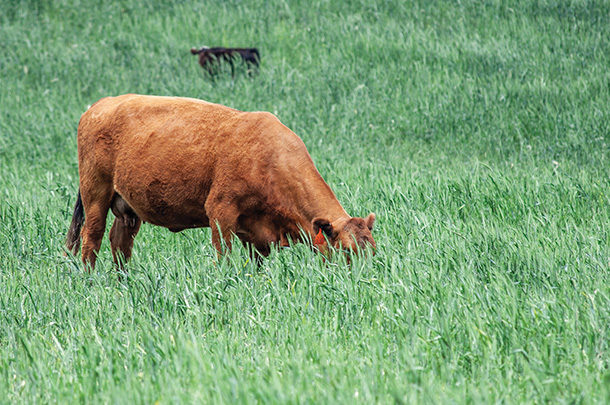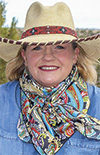Judging from the other bumper stickers on the car, my guess was the driver believed trees were the answer for all the world’s environmental woes – whatever they may be.
Because we were on a freeway with six lanes in each direction, I didn’t have the opportunity to jump out and educate the driver that cows are the answer. But no worries, I spent three days at EarthX, an environmental-conscious gathering, where I talked to literally hundreds of people and had the chance to explain that repeatedly.
The whole world is talking about carbon sequestration – at least the developed world. We are concerned about the rainforests, habitat in Africa. Yet, right here in the good old USA, we are sitting on one of the most endangered ecosystems on the planet: the prairie. Yep, you read that right. Our backyard.
Why, you ask? Who cares about the prairie? Back to the carbon sequestration thing … trees are not the answer. There’s more carbon stored in the top 3 feet of soil on this planet than all the vegetation (trees included) and all the atmosphere combined. Our soils, particularly those beneath grasslands, are the second-largest carbon sink on planet Earth, right behind the oceans. What we do on our ground matters. It matters to everyone. Plain and simple.
Many ranchers are being offered contracts to sell stored soil carbon and are eagerly accepting those contracts without knowing much at all about the science or the legal ramifications. It is one thing to contract your calves for delivery. (Most of you know how to get to the marketplace a few months later with that product.) Contracting soil carbon for delivery is another matter. Do you know what the heck you are doing? I keep hearing, “It sounds like a really good deal.” Oh boy. Ranching is tough, for sure. But we all know the old rule of thumb. “If it sounds too good to be true …”
How do you increase soil carbon?
To increase soil carbon, you’ve got to have healthy soils. What on earth does that mean? Can my soil be sick? Healthy soils mean healthy rangeland and pasture ecosystems. Which means more plant growth that ultimately translates into more pounds of beef, lamb, etc., from that ecosystem. Just like you have some basic metrics to determine human health (i.e., weight, blood pressure; all those things the doctor measures as soon as you walk through the door), soil health has some basic principles as well. Five principles are generally considered when assessing soil health:
1. Armor the soil. Protect it with vegetative cover. Is there too much bare ground? Covered soil is cooler, rich in nutrients. There’s a reason the hamburger joint cooks that burger to 140ºF – that is the temp that kills bacteria. We want and need lots of bacteria in our soils. If you think your soil surfaces exposed to sun cannot get to 140ºF in the summer, I’d suggest you get a soil thermometer in the pickup and use it.
2. Minimize soil disturbance. Plowing soil or grazing continuously can disrupt the nutrient and water cycles that keep things healthy.
3. Plant diversity. The more diverse the plant life, the healthier the soil. Different soil mycorrhizal fungi and bacteria are associated with different plants. We need lots of those critters, and we need variety.
4. Maximize actively growing plants and roots. Keep living roots in the soil as much of the time as possible; even in those blizzards in North Dakota and Montana this spring, there were living roots in the soil beneath the healthy rangelands.
5. Integrate livestock into the system. Grazing and periods of rest and recovery are beneficial for all plant ecosystems. Even cropland. Grazing is magic to rangelands and pastures. But too much grazing and no rest is exactly the opposite. Not good at all. Well-managed grazing helps achieve the first four principles listed here. Cows are indeed the answer.
What exactly am I signing up for?
For a lucrative carbon contract, you are committing to increasing soil carbon storage. How is your management going to increase the soil carbon? That list of metrics is your guide.
Here is a good place to mention something key: In any soil carbon contract, you are going to be paid for the increase in soil carbon. It will be measured when you begin the contract and again five or six years later. You are not, I repeat, not, being paid for the carbon you presently have stored in your soils. That is a global standard. If a salesman tells you different, send that salesman packing and quickly.
If you are continuously grazing, especially continuously grazing too much, you are creating more bare ground, getting less nutrients into the soil, reducing plant diversity – basically violating every rule of soil health. Thus, you are not going to increase soil carbon in five years or 10 years. Changing your system to integrate rotational grazing will increase soil health and soil carbon. How quickly those changes take place will depend upon lots of factors, climate included.
But you have no risk, right? You don’t have to pay back the contract if you get to year five and have not met the contracted amount of carbon. You just continue, no skin off your nose. But if you did not increase carbon with your management (or lack thereof) in the first five years, how is that going to change? You could be married to this commitment for years to come.
Most contracts also have provisions that after you successfully store additional carbon, you must maintain that storage for 10 years. That’s called “permanence.” All of a sudden, you are not in a five-year contract that seems “too good to be true.” You are in a 15- or 20-year commitment. Remember when we talked about perhaps needing to initiate rotational grazing or more intensive rotational grazing – that could cost in fencing and water development. Many contracts restrict the holder and do not allow USDA EQIP funding, solar projects, etc.
I would suggest you read the fine print – but not in this case. I insist you find a lawyer to read the fine print. And find one who understands a bit about the science. Talk to a scientist. Discuss your management and if it will indeed increase soil carbon. There’s lots of snake oil salesmen out there. And there’s going to be opportunities for those managing their range and pasture ecosystems well to take advantage of excellent opportunities to monetize ecosystem services we had not traditionally marketed.
As I always say: If grazing management was easy, we’d call it rocket science.










